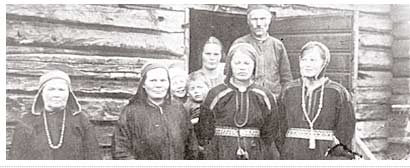

WORLD VIEW
![]()
 |
|||||
 |
|||||
WORLD VIEW |
|||||
|
|||||
|
|
|
|
|
|
|
|
The Inari Sámis, as with the Sámi people in general, have behind them a millennium of experience and skill living in nature and from nature. The endurance of nature is not overstepped. Conditions in ancient times permitted shifting to new hunting and fishing lands, as there were few inhabitants and plenty of land. The Inari Sámis have used sparingly nature and its fruits, like fish and game. In order to subsist, of course, sometimes they took a lot from the bounty of land and water, but people understood that it was necessary to let nature renew itself. Nesting game birds were not caught; neither did they fish the lakes until they were empty. Trees and bushes were not to be spoiled or felled for nothing. Forest fires were prevented by careful fire handling. During dry times in summer the mere choice of fire-making places was important as well as the size of the fire. Fires were made in damp places or by the water’s edge, and wind was to blow towards water, not the land. If the forest somehow caught fire due to e.g. lightning, nobody waited for someone else to put it out, but action was immediately taken with no efforts spared. Untouched nature was considered beautiful. Roads or even telephone lines were considered an eyesore in the landscape. There were exceptions to the above mentioned; why is not exactly known, namely the hunting to extinction of beaver and deer during the last centuries, until the end came in the 1800’s. There are sources stating that there was an agreement concerning beaver trapping between Inari and Kittilä. One account relates that there was a conflict over trapping between the citizens of Inari and Kittilä which led to the killing of Inari village Police Chief Morottaja. The Kittilä folk had started trapping earlier than was agreed. Deer hunting was also partly a joint venture of the two villages which had a joint commencement date. Why these valuable game animal species were allowed to disappear is unclear. It is against the principles of the Sámi people. One reason may have been periods when there was a lack of food. Another reason was surely the Lapland tax and the Birkarlars’ activities. The demands of these exterior powers force the Sámis to kill many more game animals than their own needs required. A third reason may be that during the 1700-1800’s other people, whose interests were centered on the same game lands, began to move to Inari. Have the Inari Sámis of the present preserved the old principles of nature conservation? Nowadays all natural economy occupations have become motorized. Reindeer husbandry and fishing cannot be done without snowmobiles, ATVs, motorboats or automobiles. The expense of these implements demands the owning of large numbers of reindeer which wears on pasturelands and nature. The conservation of nature is no longer in the hands of the Sámis but rather the whole society.
|
| |||||||||||||||
| © 2006 Sámi musea Siida & Anarâškielâ servi siida@samimuseum.fi |